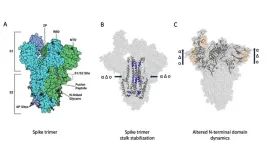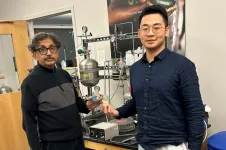(Press-News.org) Antibiotic resistance is a global health threat. In 2019 alone, an estimated 1.3 million deaths were attributed to antibiotic resistant bacterial infections worldwide. Looking to contribute a solution to this growing problem, researchers at Baylor College of Medicine have been studying the process that drives antibiotic resistance at the molecular level.
They report in the journal Molecular Cell crucial and surprising first steps that promote resistance to ciprofloxacin, or cipro for short, one of the most commonly prescribed antibiotics. The findings point at potential strategies that could prevent bacteria from developing resistance, extending the effectiveness of new and old antibiotics.
“Previous work in our lab has shown that when bacteria are exposed to a stressful environment, such as the presence of cipro, they initiate a series of responses to attempt to survive the toxic effect of the antibiotic,” said co-corresponding author Dr. Susan M. Rosenberg, Ben F. Love Chair in Cancer Research and professor of molecular and human genetics, biochemistry and molecular biology and molecular virology and microbiology at Baylor. She also is program leader in Baylor’s Dan L Duncan Comprehensive Cancer Center (DLDCCC). “We discovered that cipro triggers cellular stress responses that promote mutations. This phenomenon, known as stress-induced mutagenesis, generates mutant bacteria, some of which are resistant to cipro. Cipro-resistant mutants keep on growing, sustaining an infection that can no longer be eliminated with cipro.”
Cipro induces breaks in the DNA molecule, which accumulate inside bacteria and consequently trigger a DNA damage response to repair the breaks. The Rosenberg lab’s discoveries of the steps involved in stress-induced mutagenesis revealed that two stress responses are essential: the general stress response and the DNA-damage response.
Some of the downstream steps of the process that leads to increased mutagenesis have been revealed previously by the Rosenberg lab and her colleagues. In this study, the researchers discovered the molecular mechanisms of the first steps between the antibiotic causing DNA breaks and the bacteria turning on the DNA damage response.
“We were surprised to find an unexpected molecule involved in modulating DNA repair,” said first author Dr. Yin Zhai, postdoctoral associate in the Rosenberg lab. “Usually, cells regulate their activities by producing specific proteins that mediate the desired function. But in this case, the first step to turn on the DNA repair response was not about activating certain genes that produce certain proteins.”
Instead, the first step consisted of disrupting the activity of a protein already present, RNA polymerase. RNA polymerase is key to protein synthesis. This enzyme binds to DNA and transcribes DNA-encoded instructions into an RNA sequence, which is then translated into a protein.
“We discovered that RNA polymerase also plays a major role in regulating DNA repair,” Zhai said. “A small molecule called nucleotide ppGpp, which is present in bacteria exposed to a stressful environment, binds to RNA polymerase through two separate sites that are essential for turning on the repair response and the general stress response. Interfering with one of these sites turns off DNA repair specifically at the DNA sequences occupied by RNA polymerase.”
“ppGpp binds to DNA-bound RNA polymerase, telling it to stop and backtrack along the DNA to repair it,” said co-corresponding author Dr. Christophe Herman, professor of molecular and human genetics, molecular virology and microbiology and member of the DLDCCCC. The Herman lab found the repair-RNA-polymerase connection previously, reported in Nature.
Rosenberg’s lab discovered that DNA repair can be an error-prone process. As repair of the broken DNA strands progresses, errors occur that alter the original DNA sequence producing mutations. Some of these mutations will confer bacteria resistance to cipro. “Interestingly, the mutations also induce resistance to two other antibiotic drugs the bacteria have not seen before,” Zhai said.
“We are excited about these findings,” Rosenberg said. “They open new opportunities to design strategies that would interfere with the development of antibiotic resistance and help turn the tide on this global health threat. Also, cipro breaks bacterial DNA in the same way that the anti-cancer drug etoposide breaks human DNA in tumors. We hope this may additionally lead to new tools to combat cancer chemotherapy resistance.”
Other contributors to this work include P.J. Minnick, John P. Pribis, Libertad Garcia-Villada and P.J. Hastings, all at Baylor College of Medicine.
This study was supported by National Institutes of Health (NIH) grants R35-GM122598 and R01-CA250905, NIH Directors Pioneer Awards DP1-AI52073, DP1-AG072751 and DP1-CA174424, the BCM Cytometry and Cell Sorting Core through CPRIT Core Facility Support Award CPRIT-RP180672 and NIH awards CA125123 and RR024574.
END
Researchers uncover the first steps driving antibiotic resistance
2023-03-31
ELSE PRESS RELEASES FROM THIS DATE:
Study reveals new insights into body salt handling
2023-03-31
HUNTINGTON, W.Va. – A new study led by Marshall University researchers focuses on a novel mechanism of the body’s regulation of salt balance.
The kidney plays a central role in the body’s ability to maintain an appropriate sodium balance, which is critical for the determination of blood pressure. Disorders of sodium balance contribute to the development and progression of many common diseases, including hypertension, heart disease and stroke.
Na/K-ATPase (NKA) is the enzymatic machinery that drives absorption of sodium along the renal proximal tubule. As ...
A tighter core stabilizes SARS-CoV-2 spike protein in new emergent variants
2023-03-31
UNIVERSITY PARK, Pa. — Just as a tight core is a component of good physical fitness for humans, helping to stabilize our bodies, mutations that tightened the core of the SARS-CoV-2 spike protein in new variants may have increased the virus’s fitness.
New research led by Penn State reveals that the stem region of the spike protein became progressively tighter over time, and the team thinks this likely improved the virus’s ability to transmit through nasal droplets and infect host cells once in the body. The team said the stem region of the protein that emerged in the most recent Omicron variants is as rigid as it can get, which could ...
Status epilepticus: New inflammatory markers to improve patient care
2023-03-31
A rare and nevertheless formidable event in the landscape of epilepsies, New-Onset Refractory Status Epilepticus (NORSE) is a form of prolonged seizure in which the neurons of the epileptic focus endure a continuous discharge of neurotransmitters. It is a medical emergency requiring intensive care management. Indeed, it can cause significant long-term neurological sequelae and is associated with an average mortality rate of 12% in children and 16 to 27% in adults. NORSE can occur in response to an infection or tumor development. However, its origin remains unknown in half of the affected patients despite extensive clinical and biological ...
Making rare cell types visible: Researchers are developing a new method
2023-03-31
The human body contains more than 30 trillion cells. Until recently, the sheer number of cells in the organism meant that approaches to understanding human diseases and developmental processes based on the analysis of single cells were a futuristic vision. The development of new sequencing methods is currently revolutionising our understanding of cellular heterogeneity. These technologies can detect rare or even new cell types by extracting and sequencing the genetic information from the cells based on ribonucleic acid chains.
In cooperation ...
More than 1,200 LOINC® registrants represent 78 countries for version 2.74 webinar
2023-03-31
INDIANAPOLIS -- LOINC®, an international data standard maintained at Regenstrief Institute, hosted an educational release webinar for version 2.74. More than 1,200 participants signed up, representing 78 countries.
The hour and a half webinar served as an opportunity for the LOINC team to introduce and explain the new concepts from the 2.74 release update. Participants were presented with opportunities to learn more about each new concept and ask questions.
LOINC, short for Logical Observation Identifiers Names and Codes, is a global standard for health terminology. Created and maintained at Regenstrief, LOINC enables the identification, exchange and collection of data across ...
NRG Oncology combined trial long-term results indicate that pathologic complete response is prognostic of outcomes for soft tissue sarcoma patients
2023-03-31
Combined long-term survival results from nonrandomized phase II trial NRG Oncology RTOG 0630 and the ancillary analysis of the combined NRG-RTOG 0630/9514 trials indicate that pathologic complete response (pCR) is associated with improved survival outcomes for patients with localized soft tissue sarcoma (STS) who receive preoperative chemoradiotherapy or radiotherapy. This data suggests that pCR can be used as a prognostic factor for clinical outcomes in future STS research. These results were recently published in the JAMA Oncology.
NRG-RTOG 0630 and 9514 both evaluated STS patients who were receiving either preoperative image-guided radiotherapy (IGRT; 0630) or neoadjuvant ...
Pensoft joins Advisory Panel to further develop the Journal Comparison Service by cOAlition S
2023-03-31
Back in December, we announced that Pensoft joined 27 other publishers in sharing prices and services via the Journal Comparison Service developed by cOAlition S, in order to boost transparency in scholarly publishing.
Now, we are up to another challenge: we have joined the Advisory Panel appointed by cOAlition S to help further the improvement and development of this important service. The Advisory Panel consists of twelve members (six publishers and six end-users) representing different stakeholders in the scholarly communication ecosystem.
Journal Comparison Service (JSC) is an initiative by cOAlition S aimed to improve ...
Scallop eyes as inspiration for new microscope objectives
2023-03-31
Some species of mussels can see. Scallops, for example, have up to 200 eyes that help them detect predators such as an approaching starfish. However, the eyes of scallops differ significantly from the human eye. While in our eyes the combination of cornea and lens creates an image on the retina, in scallop eyes light is focused by a hemispherical mirror.
Optical imaging with lenses or mirrors
Creating images with mirrors instead of lenses is especially common in astronomical telescopes, in order to capture as much light as possible from planets, stars and galaxies. In the Schmidt telescope developed in the 1930s by Bernhard Schmidt (1879-1935) and still in use in many observatories today, ...
Path to net-zero carbon capture and storage may lead to ocean
2023-03-31
Lehigh Engineering researcher Arup SenGupta has developed a novel way to capture carbon dioxide from the air and store it in the “infinite sink” of the ocean.
The approach uses an innovative copper-containing polymeric filter and essentially converts CO2 into sodium bicarbonate (aka baking soda) that can be released harmlessly into the ocean. This new hybrid material, or filter, is called DeCarbonHIX (i.e., decarbonization through hybrid ion exchange material), and is described in a paper recently published in the journal Science Advances.
The research, which demonstrated a 300 percent increase in the amount of carbon captured ...
Association between daily alcohol intake and risk of all-cause mortality
2023-03-31
About The Study: In this updated systematic review and meta-analysis of 107 studies involving more than 4.8 million participants, daily low or moderate alcohol intake was not significantly associated with all-cause mortality risk, while increased risk was evident at higher consumption levels, starting at lower levels for women than men.
Authors: Jinhui Zhao, Ph.D., of the University of Victoria in Victoria, British Columbia, Canada, is the corresponding author.
To access the embargoed study: Visit our For The Media website at this link https://media.jamanetwork.com/
(doi:10.1001/jamanetworkopen.2023.6185)
Editor’s ...


